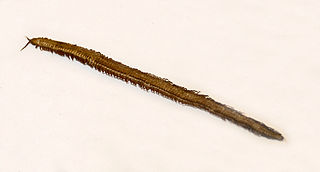Pachymerium is a genus of centipedes in the family Geophilidae found mainly in the west Palearctic region and in south Africa. Centipedes in this genus feature an elongate head, scattered coxal pores, and sternal pores in a pair of anterior groups and a posterior transverse band; the forcipular coxosternite is broad, and the ultimate article of the forcipule has a prominent basal denticle.

Geophilus hadesi is a species of soil centipede in the family Geophilidae. This centipede is a troglobite, spending its entire life cycle in a cave environment. This species and Geophilus persephones are the only two troglobites known in the order Geophilomorpha. The species G. hadesi is named after Hades, god of the underworld in Greek mythology and the husband of Persephone, the namesake of the first troglobite discovered among the soil centipedes. The species G. hadesi has been observed in a cave as far as 1,100 meters below the surface, the deepest underground that any centipede has ever been recorded.

Oryidae is a monophyletic family of soil centipedes belonging to the superfamily Himantarioidea.

Geophilus is a large, heterogeneous genus of soil centipedes in the family Geophilidae largely considered to be synonymous with Brachygeophilus. The generic name first appeared in Brewster's Edinburgh Encyclopaedia in 1814 as Geophilus electricus. This genus has a Holarctic distribution.
Geophilus arenarius is a species of soil centipede in the family Geophilidae. This centipede is found in Algeria. As part of the carpophagus species-complex, this species is closely related to both G. carpophagus and G. easoni.

Ribautia is a genus of centipedes in the family Geophilidae. This genus was described by French myriapodologist Henry Wilfred Brolemann in 1909. Centipedes in this genus are found in South America, tropical Africa, Madagascar, the Arabian peninsula, Australia, New Zealand, and Melanesia.
Schendyla is a genus of soil centipedes in the family Schendylidae. These centipedes are found in the west Palearctic region. This genus was described by Danish entomologists Vilhelm Bergsøe and Frederik Vilhelm August Meinert in 1866. This genus now includes more than 20 species.
Plesioschendyla is a monotypic genus of centipedes in the family Schendylidae. It is endemic to New Caledonia, a French overseas territory in Melanesia. Its sole species is Plesioschendyla confossa. It was described by French entomologist Henri Ribaut in 1923.
Ribautia taeniata is a species of centipede in the Geophilidae family. It is endemic to New Caledonia, a French overseas territory in Melanesia. It was first described in 1923 by French entomologist Henri Ribaut.
Pectiniunguis is a genus of centipedes in the family Schendylidae. This genus was described by American naturalist Charles Harvey Bollman in 1889. Centipedes in this genus feature second maxillae with claws fringed by two rows of filaments, transversally elliptical sternal pore-fields on almost all trunk segments, two pores on each coxopleuron, and ultimate legs without claws.
Eucratonyx is a genus of centipedes in the family Gonibregmatidae. This genus was described in 1898 by British zoologist Reginald Innes Pocock. Centipedes in this genus are found from the Andaman Islands to New Britain.
Mecistocephalus angusticeps is species of soil centipede in the family Mecistocephalidae. This centipede is found in Kenya, Seychelles, and the Chagos Archipelago. This species features only 47 pairs of legs rather than the 49 leg pairs usually observed in the genus Mecistocephalus.
Arctogeophilus is a genus of soil centipedes in the family Geophildae. These centipedes are found in subarctic and temperate regions of Asia, North America, and western Europe. The taxon Arctogeophilus was first proposed in 1909 by the Austrian myriapodologist Carl Attems as a subgenus within the genus Geophilus. The French zoologist Henri Ribaut elevated Arctogeophilus to the rank of genus in 1910.
Arctogeophilus glacialis is a species of soil centipede in the family Geophildae. This centipede is found in Russia, Alaska, and Canada. This species was first described in 1909 by the Austrian myriapodologist Carl Attems as the type species for the taxon Arctogeophilus, which was originally described as a subgenus of the genus Geophilus but was elevated to the status of genus in 1910 by the French zoologist Henri Ribaut.
Escaryus is a genus of soil centipedes in the family Schendylidae. These centipedes are notable as schendylids adapted to colder temperatures and restricted to cool climates and high latitudes. With more than 30 species, this genus is easily the largest group of such centipedes in the family Schendylidae. Most schendylids are limited to tropical or subtropical regions.
Alloschizotaenia is a genus of soil centipedes in the family Geophilidae. This genus contains only three valid species. Centipedes in this genus are found in central and east Africa.
Alloschizotaenia bipora is a species of soil centipede in the family Geophilidae. This centipede is found in Rwanda and the Democratic Republic of the Congo. This species was first described in 1952 by the Austrian myriapodologist Carl Attems.
Schendyla dentata is a species of soil centipede in the family Schendylidae. This centipede is widespread in western Europe. This species is notable not only for its small size, reaching only 12 mm in length, but also for the absence of males in all samples collected. This absence of males suggests that this species reproduces through parthenogenesis.
Escaryus hirsutus is a species of soil centipede in the family Schendylidae. This centipede is found on Sakhalin island in the Russian Far East. This species was first described in 1973 by the Russian myriapodologist Lidia P. Titova.
Escaryus kirgizicus is a species of soil centipede in the family Schendylidae. As the species name suggests, this centipede is found in Kyrgyzstan. This species is known only from high mountains and is notable for being found at one of the highest altitudes recorded for any centipede in the order Geophilomorpha in Central Asia.



